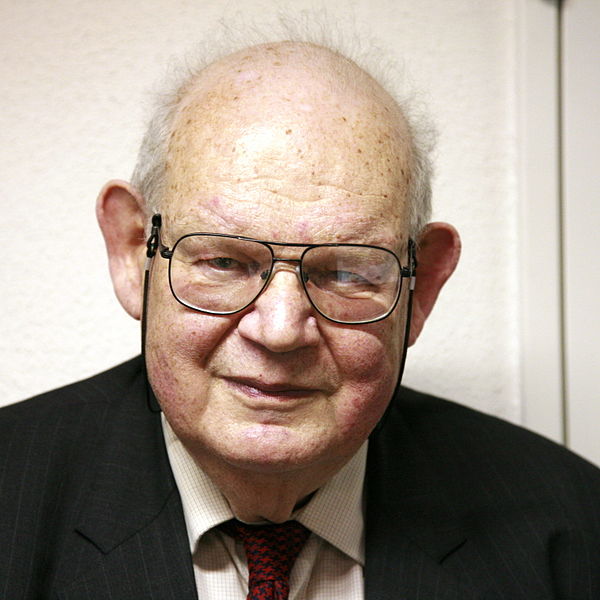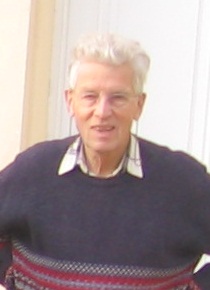<Back to Index>
- Mathematician Benoit B. Mandelbrot, 1924
- Mathematician and Astronomer Michel Hénon, 1931
PAGE SPONSOR

Benoît B. Mandelbrot (20 November 1924 – 14 October 2010) was a French American mathematician. Born in Poland, he moved to France with his family when he was a child. Mandelbrot spent much of his life living and working in the United States, and he acquired dual French and American citizenship.
Mandelbrot worked on a wide range of mathematical problems, including mathematical physics and quantitative finance, but is best known as the father of fractal geometry. He coined the term fractal and described the Mandelbrot set. Mandelbrot extensively popularized his work, writing books and giving lectures aimed at the general public.
Mandelbrot spent most of his career at IBM's Thomas J. Watson Research Center, and was appointed as an IBM Fellow. He later became a Sterling Professor of Mathematical Sciences at Yale University, where he was the oldest professor in Yale's history to receive tenure. Mandelbrot also held positions at the Pacific Northwest National Laboratory, Université Lille Nord de France, Institute for Advanced Study and Centre National de la Recherche Scientifique.
Mandelbrot was born in Warsaw into a Jewish family from Lithuania. Mandelbrot was born into a family with a strong academic tradition - his mother was a dentist and he was introduced to mathematics by two of his uncles, one of whom, Szolem Mandelbrojt, was a mathematician who resided in Paris. However, his father made his living trading clothing. Anticipating the threat posed by Nazi Germany, the family fled from Poland to France in 1936 when he was 11. Mandelbrot attended the Lycée Rolin in Paris until the start of World War II, when his family moved to Tulle, France. He was helped by Rabbi David Feuerwerker, the Rabbi of Brive - la - Gaillarde, to continue his studies. In 1944 he returned to Paris. He studied at the Lycée du Parc in Lyon and in 1945 - 47 attended the École Polytechnique, where he studied under Gaston Julia and Paul Lévy. From 1947 to 1949 he studied at California Institute of Technology, where he earned a master's degree in aeronautics. Returning to France, he obtained his Ph.D. degree in Mathematical Sciences at the University of Paris in 1952.
From 1949 to 1958 Mandelbrot was a staff member at the Centre National de la Recherche Scientifique. During this time he spent a year at the Institute for Advanced Study in Princeton, New Jersey, where he was sponsored by John von Neumann. In 1955 he married Aliette Kagan and moved to Geneva, Switzerland, and later to the Université Lille Nord de France. In 1958 the couple moved to the United States where Mandelbrot joined the research staff at the IBM Thomas J. Watson Research Center in Yorktown Heights, New York. He remained at IBM for 35 years, becoming an IBM Fellow, and later Fellow Emeritus.
From 1951 onward, Mandelbrot worked on problems and published papers not only in mathematics but in applied fields such as information theory, economics, and fluid dynamics. He became convinced that two key themes, fat tails and self - similar structure, ran through a multitude of problems encountered in those fields.
Mandelbrot found that price changes in financial markets did not follow a Gaussian distribution, but rather Lévy stable distributions having theoretically infinite variance. He found, for example, that cotton prices followed a Lévy stable distribution with parameter α equal to 1.7 rather than 2 as in a Gaussian distribution. "Stable" distributions have the property that the sum of many instances of a random variable follows the same distribution but with a larger scale parameter.
Mandelbrot also put his ideas to work in cosmology. He offered in 1974 a new explanation of Olbers' paradox (the "dark night sky" riddle), demonstrating the consequences of fractal theory as a sufficient, but not necessary, resolution of the paradox. He postulated that if the stars in the universe were fractally distributed (for example, like Cantor dust), it would not be necessary to rely on the Big Bang theory to explain the paradox. His model would not rule out a Big Bang, but would allow for a dark sky even if the Big Bang had not occurred.
In 1975, Mandelbrot coined the term fractal to describe these structures, and published his ideas in Les objets fractals, forme, hasard et dimension (1975; an English translation Fractals: Form, Chance and Dimension was published in 1977). Mandelbrot developed here ideas from the article Deux types fondamentaux de distribution statistique (1938; an English translation Two Basic Types of Statistical Distribution) of Czech geographer, demographer and statistician Jaromír Korčák.
While on secondment as Visiting Professor at Harvard University in 1979, Mandelbrot began to study fractals called Julia sets that were invariant under certain transformations of the complex plane. Building on previous work by Gaston Julia and Pierre Fatou, Mandelbrot used a computer to plot images of the Julia sets of the formula z2 − μ. While investigating how the topology of these Julia sets depended on the complex parameter μ he studied the Mandelbrot set fractal that is now named after him. (Note that the Mandelbrot set is now usually defined in terms of the formula z2 + c, so Mandelbrot's early plots in terms of the earlier parameter μ are left – right mirror images of more recent plots in terms of the parameter c.)
In 1982, Mandelbrot expanded and updated his ideas in The Fractal Geometry of Nature. This
influential work brought fractals into the mainstream of professional
and popular mathematics, as well as silencing critics, who had dismissed
fractals as "program artifacts".
Mandelbrot left IBM in 1987, after 35 years and 12 days, when IBM decided to end pure research in his division. He joined the Department of Mathematics at Yale, and obtained his first tenured post in 1999, at the age of 75. At the time of his retirement in 2005, he was Sterling Professor of Mathematical Sciences. His awards include the Wolf Prize for Physics in 1993, the Lewis Fry Richardson Prize of the European Geophysical Society in 2000, the Japan Prize in 2003, and the Einstein Lectureship of the American Mathematical Society in 2006.
The small asteroid 27500 Mandelbrot was named in his honor. In November 1990, he was made a Knight in the French Legion of Honor. In December 2005, Mandelbrot was appointed to the position of Battelle Fellow at the Pacific Northwest National Laboratory. Mandelbrot was promoted to Officer of the Legion of Honor in January 2006. An honorary degree from Johns Hopkins University was bestowed on Mandelbrot in the May 2010 commencement exercises.
Although Mandelbrot coined the term fractal, some of the mathematical objects he presented in The Fractal Geometry of Nature had been described by other mathematicians. Before Mandelbrot, they had been regarded as isolated curiosities with unnatural and non - intuitive properties. Mandelbrot brought these objects together for the first time and turned them into essential tools for the long stalled effort to extend the scope of science to non - smooth objects in the real world. He highlighted their common properties, such as self - similarity (linear, non - linear, or statistical), scale invariance, and a (usually) non - integer Hausdorff dimension.
He also emphasized the use of fractals as realistic and useful models of many "rough" phenomena in the real world. Natural fractals include the shapes of mountains, coastlines and river basins; the structures of plants, blood vessels and lungs; the clustering of galaxies; and Brownian motion. Fractals are found in human pursuits, such as music, painting, architecture, and stock market prices. Mandelbrot believed that fractals, far from being unnatural, were in many ways more intuitive and natural than the artificially smooth objects of traditional Euclidean geometry:
Clouds are not spheres, mountains are not cones, coastlines are not circles, and bark is not smooth, nor does lightning travel in a straight line.
—Mandelbrot, in his introduction to The Fractal Geometry of Nature
Mandelbrot has been called a visionary and a maverick. His informal and passionate style of writing and his emphasis on visual and geometric intuition (supported by the inclusion of numerous illustrations) made The Fractal Geometry of Nature accessible to non - specialists. The book sparked widespread popular interest in fractals and contributed to chaos theory and other fields of science and mathematics.
When visiting the Museu de la Ciència de Barcelona in 1988, he told its director that the painting The Face of War had given him "the intuition about the transcendence of the fractal geometry when making intelligible the omnipresent similitude in the forms of nature". He also said that, fractally, Gaudí was superior to Van der Rohe.
Mandelbrot died in a hospice in Cambridge, Massachusetts, on 14 October 2010 from pancreatic cancer, at the age of 85. Reacting to news of his death, mathematician Heinz - Otto Peitgen said
"if we talk about impact inside mathematics, and applications in the
sciences, he is one of the most important figures of the last 50 years." Chris Anderson described Mandelbrot as "an icon who changed how we see the world." French President Nicolas Sarkozy said
Mandelbrot had "a powerful, original mind that never shied away from
innovating and shattering preconceived notions". Sarkozy also added,
"His work, developed entirely outside mainstream research, led to modern
information theory." Mandelbrot's
obituary in The Economist points out his fame as "celebrity beyond the
academy" and lauds him as the "father of fractal geometry."

Michel Hénon (1931, Paris - 7 April 2013, Nice) was a French mathematician and astronomer. He was at the Nice Observatory.
In astronomy, Hénon is well known for his contributions to stellar dynamics. In late 1960s and early 1970s he was involved in dynamical evolution of star clusters, in particular the globular clusters. He developed a numerical technique using Monte Carlo methods to follow the dynamical evolution of a spherical star cluster much faster than the so-called n-body methods.
In mathematics, he is well known for the Hénon map, a simple discrete dynamical system that exhibits chaotic behavior.
He published a two volume work on the restricted three - body problem.